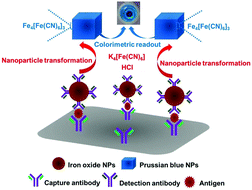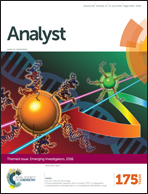Cost-effective and sensitive colorimetric immunosensing using an iron oxide-to-Prussian blue nanoparticle conversion strategy†
Abstract
The development of new sensitive, cost-effective and user-friendly colorimetric bioassays is in increasing demand to meet the requirement of modern clinical diagnostics and field detection. Herein, a novel iron oxide-to-Prussian blue (PB) nanoparticle (NP) conversion strategy was developed and applied to sensitive colorimetric immunosensing of cancer biomarkers. In a typical sandwich-type immunosensing system, the captured spherical antibody-conjugated iron oxide NPs were transformed into cubic PB NPs, which exhibited a highly visible blue color with high molar extinction coefficients. Hence, a new colorimetric immunosensing strategy was developed as a result of this low cost and simple transformation process. Without the aid of any complex nanoparticle stabilizing ligands and signal amplification processes, prostate-specific antigen as a model analyte can be detected at a concentration as low as 1.0 ng mL−1 by the naked eye with good reliability for detection of real human serum samples. This is the first attempt to develop and apply the iron oxide-to-PB NP colorimetric conversion strategy for immunosensing, and shows great promise for the development of new sensitive, cost-effective and user-friendly colorimetric bioassays in various bioanalytical applications, especially in low-resource settings.

- This article is part of the themed collection: Emerging Investigators

 Please wait while we load your content...
Please wait while we load your content...